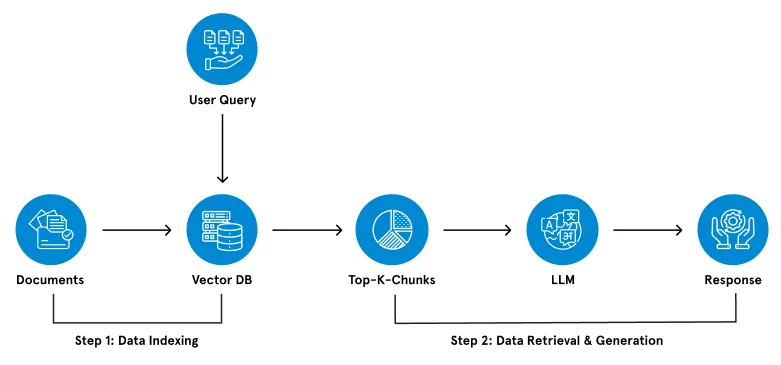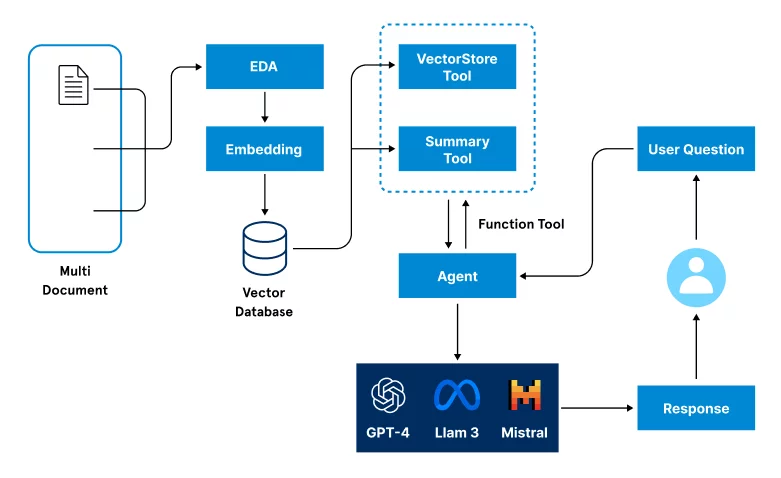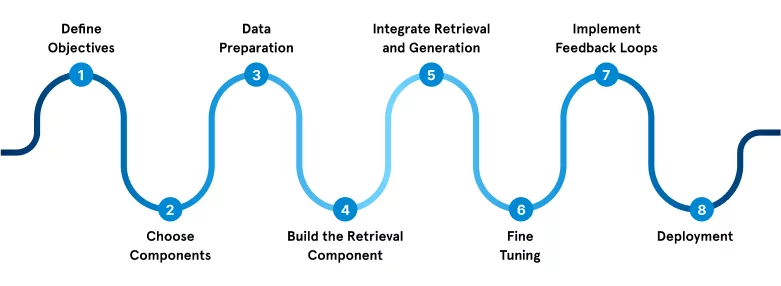With companies leveraging artificial intelligence (AI) for more informed and efficient decision making and automation, the requirement for systems that retrieve and generate accurate, related information has grown up. One such approach is agentic RAG (Retrieval-Augmented Generation), a cutting-edge AI framework that integrates retrieval mechanisms with generative models to produce precise and relevant outputs.
By enabling AI agents to access and pull from external knowledge sources before generating content, agentic RAG ensures more reliable and informed responses. In this blog, we will explore what agentic RAG is, its features, various types, and best practices for implementation in modern enterprises.
What is agentic RAG?
Agentic RAG is one of the most complex AI architectures, merging retrieval-based model strength with the generative capabilities of AI into more accurate context-driven outputs. Classic generative AI models only depend on pre-trained data, which does not really assist them in delivering current or domain-specific information.
Agentic RAG overcomes this limitation by incorporating an additional retrieval layer that allows the AI to fetch relevant data from external sources, such as databases, documents, or APIs, before generating its final output.
This hybrid approach enhances the model’s decision-making capabilities, as it can supplement its generative process with real-time or highly specialized data. This results in more precise and contextually relevant responses.
Agentic RAG has wonderful usability when accuracy of information is crucial. Such scenarios include customer support services, legal research, healthcare, finance, and beyond. With the help of AI consulting services, organizations can enhance the quality of automatic responses based on the ability of AI to dynamically access external knowledge, making AI-driven solutions intelligent and more reliable.
Key features of agentic RAG:
- Retrieval component: Agentic RAG pulls relevant information from a knowledge base or database to provide factual accuracy and contextual relevance for the generative process. It enhances the retrieval process by understanding the input query’s context and nuances, enabling more precise and efficient results.
- Generative component: After retrieving the necessary information, the generative model uses advanced NLP techniques to create coherent, context-aware responses based on the data retrieved.
- Agentic behavior: The model demonstrates agency by deciding which information to retrieve, based on the query or context, allowing it to generate more customized and relevant responses.
- Dynamic information use: Agentic RAG adapts to new information, retrieving the most up-to-date data, making it suitable for applications that require constantly updated knowledge.
- Enhanced accuracy: By combining retrieval with generation, agentic RAG reduces errors and improves the reliability of the responses it generates.
- Scalability: The system is designed to scale with larger datasets, improving its performance as more data becomes available.
- User interaction: Agentic RAG can engage in real time, interactive dialogue through the retrieval component to give information as per the input given by a user.
- Continuous learning: From time to time, intelligent agents continue to improve their capabilities, enhancing their knowledge base and ability to tackle complex problems while encountering new data and challenges.
Suggested: Agentic AI: Redefining the future artificial intelligence
What are the differences between traditional RAG and agentic RAG:
| Feature | Traditional RAG | Agentic RAG |
|---|---|---|
| Prompt engineering | More dependent on manual prompt engineering and techniques of optimization | Dynamic adjustment of prompts as per the context and objectives |
| Static nature | Less knowledge of context and static retrieval decision making | Examines conversation history and adjusts strategies as per context |
| Overhead | Inefficient retrieval and excessive text generation may increase cost | Optimizes retrievals and reduces extra text generation, minimizing costs |
| Multi-step complexity | Needs extra classifiers and models | Manages multi-step reasoning and tool usage |
| Decision making | Static rules administer retrieval and response creation | Takes decision for information retrieval, assess retrieval data quality, checks responses |
| Retrieval process | Depends on original query to retrieve associated documents | Acts in the environment to collect extra details pre and post retrieval |
| Adaptability | Restricted ability for adaptation to change in situation and information | Adjusts on the basis of feedback and real time observation |
Some functions of agentic RAG
1. RAG as pipeline as a tool – Agents can leverage pre-existing RAG pipelines to streamline tasks and utilize the built-in capabilities of the system.
2. Standalone RAG tool – Agents can function independently as RAG tools, generating responses based solely on input queries without external dependencies.
3. Dynamic tool retrieval – Agents retrieve relevant tools, like a vector index, based on query context, adjusting actions to meet specific requirements.
4. Query planning – Agents analyze queries and select suitable tools from a predefined set, optimizing outcomes based on query needs.
5. Selection of tools – Agents assist in choosing the most appropriate tool from available options, ensuring alignment with the query’s context and goals.
Basic RAG pipeline

How agentic RAG is advancing RAG pipelines with intelligent agent services:
1. Query understanding and decomposition – Agents break down complex queries into smaller sub-queries, enabling more efficient handling by the RAG pipeline.
2. Knowledge base management – Agents manage and curate the knowledge base, selecting relevant data sources, updating information, and ensuring optimal data use for each query.
3. Retrieval strategy selection – Agents choose and optimize the best retrieval strategies (e.g., semantic similarity, keyword matching) based on the task requirements.
4. Result synthesis and post-processing – Agents refine and enhance generated outputs by synthesizing data from multiple sources, resolving inconsistencies, and applying domain-specific knowledge.
5. Iterative querying and feedback – Agents support an iterative process, adjusting retrieval and generation based on user feedback and clarifying queries when necessary.
6. Task orchestration and coordination – For multi-step tasks, agents manage and coordinate sub-tasks within the pipeline, combining intermediate results into a final output.
7. Multimodal integration – Agents enable the use of multimodal data (e.g., images, audio) within the pipeline, enhancing its capabilities for complex queries.
8. Continuous learning and adaptation – Agents monitor performance, fine-tune strategies, and adapt the system based on user feedback and evolving data to improve accuracy over time.
Agentic RAG diagram

Types of agentic RAG:
1. Routing agent: A routing agent uses a large language model (LLM) to analyze input queries and select the appropriate RAG pipeline. Another routing includes selecting between summarization or question-answering pipelines.
2. One-shot query planning agent: This agent breaks down complex queries into subqueries, which are executed across various RAG pipelines in parallel. It then synthesizes the results into a final comprehensive response.
3. Tool use agent: Beyond retrieving documents, this agent gathers additional data from external sources (e.g., APIs, databases) to enhance the input query for better processing by the LLM.
4. React agent: The React agent combines routing, query planning, and tool use, iterating over complex, multi-part queries. It decides on tools, stores outputs, and maintains the query state until tasks are completed.
5. Dynamic planning & execution agent: This agent handles complex user intents, focusing on long-term planning, efficiency, and parallel execution. It separates high-level planning from short-term tasks, outlining steps and determining tools to achieve the query goal efficiently.
Basic steps to implement agentic RAG framework:

1. Define objectives: Identify tasks suitable for RAG (e.g., chatbots, information retrieval) and set specific goals, such as improving response accuracy and relevance.
2. Choose components: Select a retrieval system (e.g., BM25, Dense Passage Retrieval) and a generative model (e.g., GPT, BERT) to handle retrieval and response generation.
3. Data preparation: Gather relevant documents, then clean and preprocess the data for compatibility with the retrieval and generative systems.
4. Build the retrieval component: Implement indexing for efficient document search and design a method for processing user queries into a retrievable format.
5. Integrate retrieval and generation: Create a pipeline where the retrieval component fetches documents, and the generative model produces responses based on both the documents and the query.
6. Fine-tuning: Fine-tune the generative model on relevant datasets and continuously evaluate for accuracy, relevance, and coherence.
7. Implement feedback loops: Use user feedback to improve responses and retrain the models periodically to maintain performance.
8. Deployment: Develop APIs for external access and set up monitoring tools to track performance and user interactions.
Discover the transformative power of generative AI
Key tools for building an agentic RAG system:
LlamaIndex
LlamaIndex provides a solid foundation for developing agentic systems with robust features like document agents, agent interaction management, and advanced reasoning techniques like Chain-of-Thought. It integrates easily with diverse data sources, including Google, Wikipedia, SQL, and vector databases, and supports Python code execution.
LangChain
LangChain offers a comprehensive toolkit for building agentic systems, facilitating interaction among agents and integration with external resources. Its flexible framework supports a wide range of functionalities, including search, database management, and code execution.
The importance of adopting agentic RAG for businesses
Incorporating agentic RAG into business operations is a game-changer for organizations seeking to enhance efficiency, accuracy, and adaptability. By leveraging intelligent agent services to manage complex queries, optimize retrieval strategies, and facilitate dynamic decision-making, agentic RAG systems go beyond traditional RAG frameworks. They offer improved scalability, continuous learning, and the ability to handle multi-step, high-complexity tasks with precision.
For companies looking to stay competitive, adopting agentic RAG provides a powerful tool to streamline processes, make informed decisions, and adapt to evolving market needs. Embracing this advanced AI framework ensures businesses remain agile and future ready. Talk to our experts for more information.









